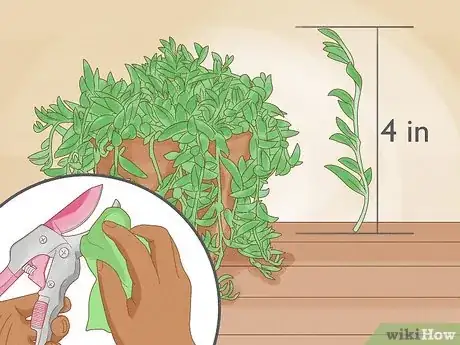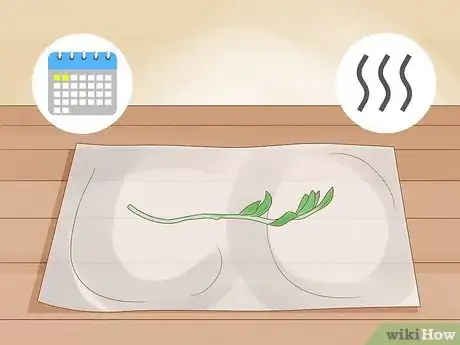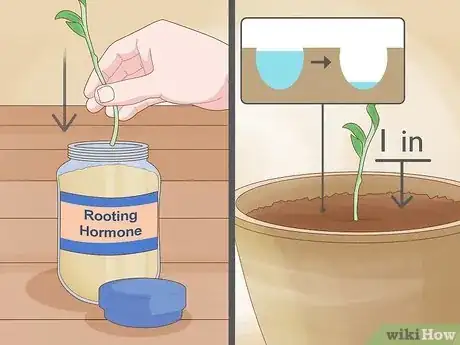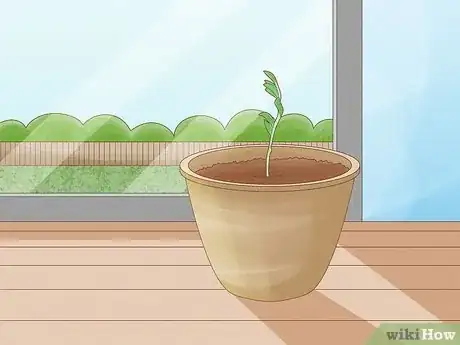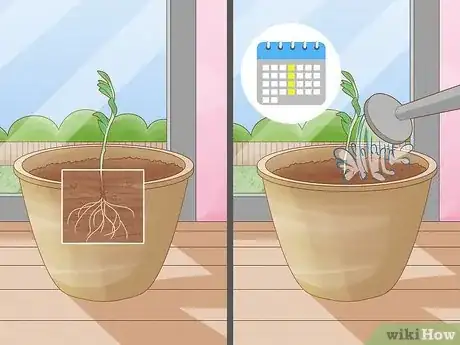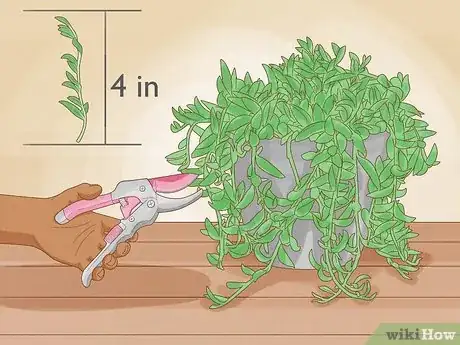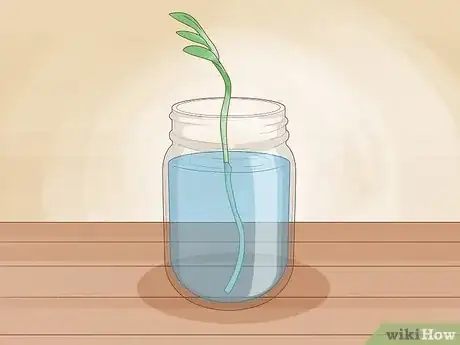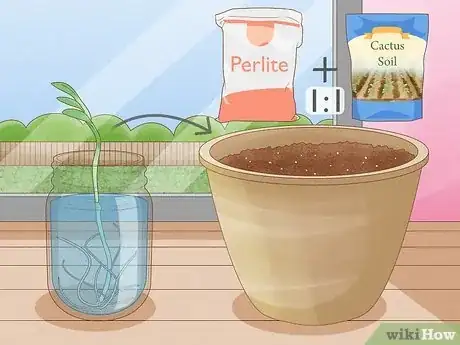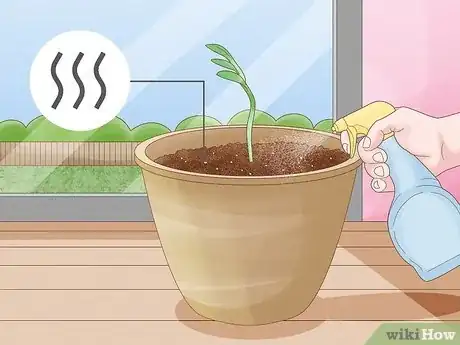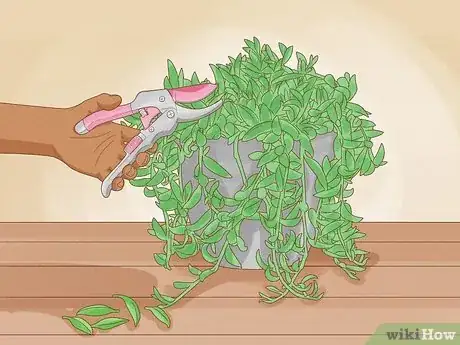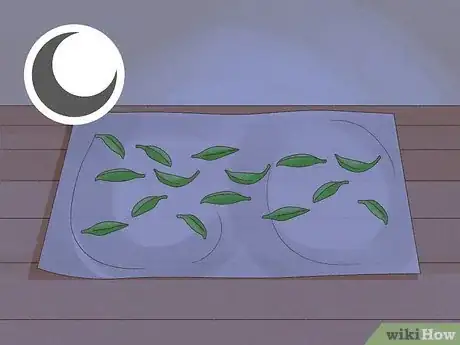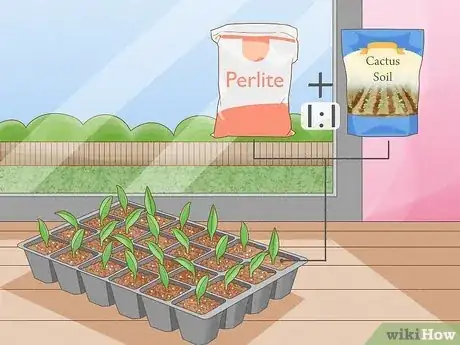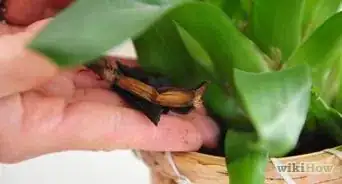This article was co-authored by Jon Rowland and by wikiHow staff writer, Dev Murphy. Jon Rowland is a Plant Specialist and the Founder of the Green House Center blog. With over eight years of plant and garden experience, he specializes in greenhouse care, lawn and garden maintenance, and home appliance recommendations. Jon aims to share his knowledge so that others can live a more convenient, efficient, and environmentally friendly lifestyle.
This article has been viewed 1,862 times.
String of bananas are fun succulents that are not only easy to maintain, but easy to propagate too. All you need is a few short cuttings or leaves and some soil or water, and you’re ready to begin the propagation process. Whether you’ve got a string of bananas plant you want to multiply, or a few cuttings or leaves fell off your succulent and you don’t want to just toss them, keep on reading! We’ve got 3 tried and true methods for string of bananas propagation that’ll multiply your string of bananas in no time.
Things You Should Know
- Take a string of bananas cutting at least 1 in (2.5 cm) long with a few leaves on it. Place it in water, or let it dry out and plant it in well-draining soil.
- Keep your string of bananas plant in indirect, bright sunlight, and mist it with water for the first few days while it develops roots. Be careful not to overwater your string of bananas.
- For best results, propagate your plant from cuttings rather than leaves. Propagating from string of banana leaves is the trickiest method.
Steps
Propagating Cuttings in Soil
-
1Take a cutting of at least 4 in (10 cm). Use disinfected clippers or a sharp knife to trim a string off an established plant. Be sure to take a cutting that isn't shriveled and that has a couple of nodes (tiny knobs from which new roots will grow) and a few leaves. Cut off the leaves from the bottom 1 in (2.5 cm) or so, as this part of the cutting will go in the soil.[1]
- The longer the cutting you can get, the better: a cutting with developed roots will be hardier than a short rootless cutting and will take no time at all to propagate.
- To increase your odds of success, take a few cuttings to propagate.
- You can propagate a string of bananas at any point in the year, but spring, summer, and fall are the best times as the plant may struggle to grow in cold weather.
-
2Lay the cutting on a paper towel and dry it out for 2 days. Let the cutting air-dry in indirect sunlight, in a place where it won't be disturbed. The cutting needs to be dry before you plant it or else it could develop root rot. You'll know when it's dry enough when the bottom of the cutting, where you removed it from the plant, looks dry and "scabby."[2]
- If you’re in a hurry, you can skip or shorten the 2 days of drying out your cutting, but keep in mind that if your cutting is too wet when you plant it, it might develop root rot.
Advertisement -
3Plant the cutting in well-draining potting soil. It’s important that the soil is well-draining so that the cuttings can easily develop new roots and so that they don’t rot. We suggest using a 1 to 1 combination of cactus or succulent potting mix and perlite in a pot with drainage holes. Use your pinky finger or a chopstick to “drill” a hole at least an 1 in (2.5 cm) into the soil, and then plant your cutting inside the hole. Plant one cutting per hole.[3]
- Dip your cutting in a rooting hormone before planting, if you want. It’s not mandatory, but it can speed up the growing process.
- Don’t bury any “leaves” as they may rot: if you’ve got too many leaves on the end of your cutting still, carefully trim them with your clippers.
- You can also lay your cuttings on top of the soil rather than planting them. The cuttings will grow roots anywhere they’re touching the soil.
- To prevent the cuttings from pulling out of the loose soil, consider pinning them in place with floral pins.[4]
-
4Keep the plant in bright, indirect sunlight. Direct sunlight will cause your succulent to shrivel, especially at this early stage when your cutting is just developing roots. Too little sunlight will cause it to wilt.
-
5Mist the plant every few days to keep the soil moist. Give your cuttings time to settle in before watering, and then use a spray bottle to mist the cuttings so as not to disturb them. As succulents require very dry soil, watering them too early on in the propagation process can cause them to rot.[5]
- The closer to the surface you plant your cuttings, the faster they’ll dry out and the more frequently they’ll need to be watered.
-
6Switch to weekly watering once the cutting develops roots. After about 2 weeks, the plant’s roots will have developed enough for you to water them directly. You don’t need much water—just sprinkle enough water to ensure the surface of the soil is damp. After a few months, the plant will develop shoots. Keep your succulent in bright, indirect light.[6]
- You may be able to see the roots or new growth on the plant above the surface of the soil, but if not, gently tug at the plant. If it resists, this mean it's grown roots under the soil.
- The more humid an environment you live in, the less often you’ll have to water your plant.
- Once your cuttings have developed roots, you can repot your plant in a new pot with drainage holes and well-draining soil, but you can also keep it in its original pot.
Propagating Cuttings in Water
-
1Take a 4 in (10 cm) cutting from a developed string of bananas plant. Pick a cutting that has at least 2 leaves on it and a couple of nodes. Node are little knobs on the stem from which new roots will sprout. Try to pick a cutting that is fresh with plump leaves, as this means it is hardy and will propagate faster than a weaker cutting.[7]
- The more developed your cutting is, the easier it will be to propagate. If you can, try to get a cutting with roots.
-
2Put your cutting in a see-through container of water. To propagate your succulent properly, make sure to submerge only the bottom tip of the cutting, and don’t submerge any leaves. If any leaves are touching the water, remove them—just make sure you have at least 2 leaves still remaining, and a few nodes. Use a clear container so that you can monitor your plant’s progress.
-
3Keep the plant in indirect sun, and change the water every few days. Your see-through container will help you monitor the water levels. Make sure the plant’s nodes are submerged in the water; this is where the new roots will form.[8]
- The bottom tip of your plant must be submerged at all times, so make sure to change the water every few days. If you don’t change the water, it can grow bacteria or evaporate.
-
4Transfer your plant to well-draining soil once multiple new roots have formed. Wait 2 weeks for roots to develop, and then plant your cutting in soil. We recommend using a 1 to 1 mixture of perlite and cactus or succulent soil and planting your cuttings in a pot with drainage holes to prevent water buildup.[9]
- Roots may develop more or less quickly depending on the season and your location: hotter climates and seasons will encourage faster growth, while colder climates and seasons may cause your plant to grow more slowly, even taking as long as a few months to develop roots.
-
5Mist the soil with water when it gets dry, until the plant is established. Once the plant is established in the soil, you can water it from a cup or watering can once a week (or whenever the top soil is dry), but until it's settled in the soil, it’ll be pretty fragile. While it’s getting established in its new pot, mist it gently with a spray bottle whenever the top of the soil dries out.[10]
- Overwatering can cause root rot or infections, especially when the plant is brand new. Be careful not to water your plant unless the soil is dry.
Leaf Propagation
-
1Take a few leaves from a developed string of bananas plant. The plumper the leaves, the better. String of bananas are low-maintenance, but this doesn’t mean they’re not delicate: to remove a leaf, gently twist it off with your fingers, or use your clippers or a sharp knife. Let them dry overnight, or until the cut ends become hard and calloused.[11]
- Leaf propagation isn’t the most reliable form of succulent propagation, but if your string of bananas has lost a few leaves, why not try growing some more plant friends?
-
2Lay your leaves out on paper towels to dry overnight. Keep them in indirect sunlight, in a place where they won't be disturbed. After a couple of days, the cut end of the leaves should have formed a callous.[12]
-
3Place the leaves on well-draining potting mix in bright, filtered sunlight. For best results, combine perlite and cactus or succulent soil in a1 to 1 ratio and put your soil combination in a pot with drainage holes in the bottom to prevent water retention. The leaves will slowly establish roots in the soil.[13]
- Be sure to use well-draining soil so that the leaves can easily establish new roots and so the roots don’t develop root rot. Root rot occurs when roots become too damp for too long.
-
4Mist your plant with water whenever the soil dries. Roots will take a couple of weeks to grow, and then shoots will take several months. After the plant has established roots in the soil, you can water it directly.[14]
- Propagating string of bananas from leaves is the trickiest propagation method, but it’s worth a shot!
Things You’ll Need
- Clippers or a sharp knife
- Pot with drainage holes
- Perlite
- Cactus or succulent potting soil
- String of bananas
- Floral pins (optional)
- Rooting hormone (optional)
References
- ↑ https://cactusway.com/how-to-easily-propagate-string-of-bananas/
- ↑ https://www.succulentsandsunshine.com/how-to-propagate-succulents-from-leaves-and-cuttings/
- ↑ https://cactusway.com/how-to-easily-propagate-string-of-bananas/
- ↑ https://www.joyusgarden.com/string-of-bananas-propagation/
- ↑ https://www.joyusgarden.com/string-of-bananas-propagation/
- ↑ https://cactusway.com/how-to-easily-propagate-string-of-bananas/
- ↑ https://cactusway.com/how-to-easily-propagate-string-of-bananas/
- ↑ https://cactusway.com/how-to-easily-propagate-string-of-bananas/
- ↑ https://cactusway.com/how-to-easily-propagate-string-of-bananas/
- ↑ https://cactusway.com/how-to-easily-propagate-string-of-bananas/
- ↑ https://www.succulentsandsunshine.com/how-to-propagate-succulents-from-leaves-and-cuttings/
- ↑ https://gardenerspath.com/how-to/propagation/succulents-five-easy-steps/
- ↑ https://cactusway.com/how-to-easily-propagate-string-of-bananas/
- ↑ https://www.succulentsandsunshine.com/how-to-propagate-succulents-from-leaves-and-cuttings/
